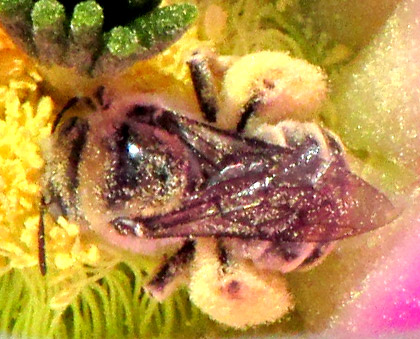Excerpts from Jim Conrad's
Naturalist Newsletter
entry dated May 18, 2023, issued from near Tequisquiapan, elevation about 1,900m (6200 ft), Querétaro state, MÉXICO
(~N20.55°, ~W99.89°)
CHIMNEY BEE

Out in the overgrazed scrub, a colony of hedgehog cacti had begun flowering and I paused to admire the large, red flowers. The bee species pictured above was busy visiting one blossom after another, in the process collecting plenty of pollen not only on her legs but on her whole body. Arriving atop a flower's hundreds of pale yellow stamens, it would dig into the stamens head-first, sometimes briefly disappearing into them, then returning to the surface and walking over them. At one time three bees, all of the same kind, were in one blossom, mostly ignoring the dozen or so other blossoms in the colony. They were too small to be honeybees, so I tried for a picture that would show wing venation, probably needed for identification. They were moving fast, but this picture resulted:

Just to see how wing venation can vary, you might like to compare it in the above wing with that of a honeybee. In the above picture, note that after three main veins arise at the wing base, they fan out toward the wing tip and soon meet with a crossvein. That's not to be seen on honeybee wings, or wings of other bees I've looked at closely. Also, the back legs of these smaller bees possess much longer hairs in which pollen collects.
NOTE: At this point in my original notes, using the wonderful Bugguide.Net website, I report on how I made the mistake of identifying our bee as a member of the Melittid Bee Family, the Melittidea, a small family with only about 200 described species. Once this page was published, James Hung at Oklahoma University wrote that the photographed bee actually is a chimney bee, genus Diadasia, and a member of the DIADASIA AUSTRALIS SPECIES COMPLEX composed of maybe around five species.
Bugguide.Net provides a special, well illustrated Australis Species Group page. During my error-making process, Bugguide.Net was in no way faulty; it was my own ineptness dealing with insects, and simply the nature of dealing with insect IDs, especially at understudied locations such as here. In the end, however, the page served its purpose, by showing a specialist, James, what I was seeing, and we all ended up with a page featuring an expert identification.
Now having a proper ID, I can "look up the name" and find that taxa of the Diadasia australis species group are described as "oligolectic," meaning that they exhibit a narrow, specialized preference for pollen sources, typically to a single family or genus of flowering plants. Members of our Diadasia australis complex of species occur from southwestern Canada south through the western US into Mexico south to Oaxaca. That's a large distribution area and one can visualize the species evolving into various geographically distinct taxa which could or could not constitute separate species, depending on one's inclinations.
We've seen another kind of chimney bee before, a member of the genus Anthophora, also identified with the help of a specialist. The photo of that bee better shows the long, yellow hairs on the pollen-collecting leg, and wing venation.
In Spanish, bees of the genus Diadasia often are called abejas de los cactos, or "cactus bees." The Costa Rican page for the genus, in Spanish, tells us that our pollen-collecting bees nest in the soil, and specialize in collecting pollen from a relatively small number of plant species, especially in the Hibiscus Family, the Malvaceae, which may the ancestral host of the genus Diadasia. Flowers in the Hibiscus Family usually produce numerous stamens with plenty of pollen, just like our cacti.